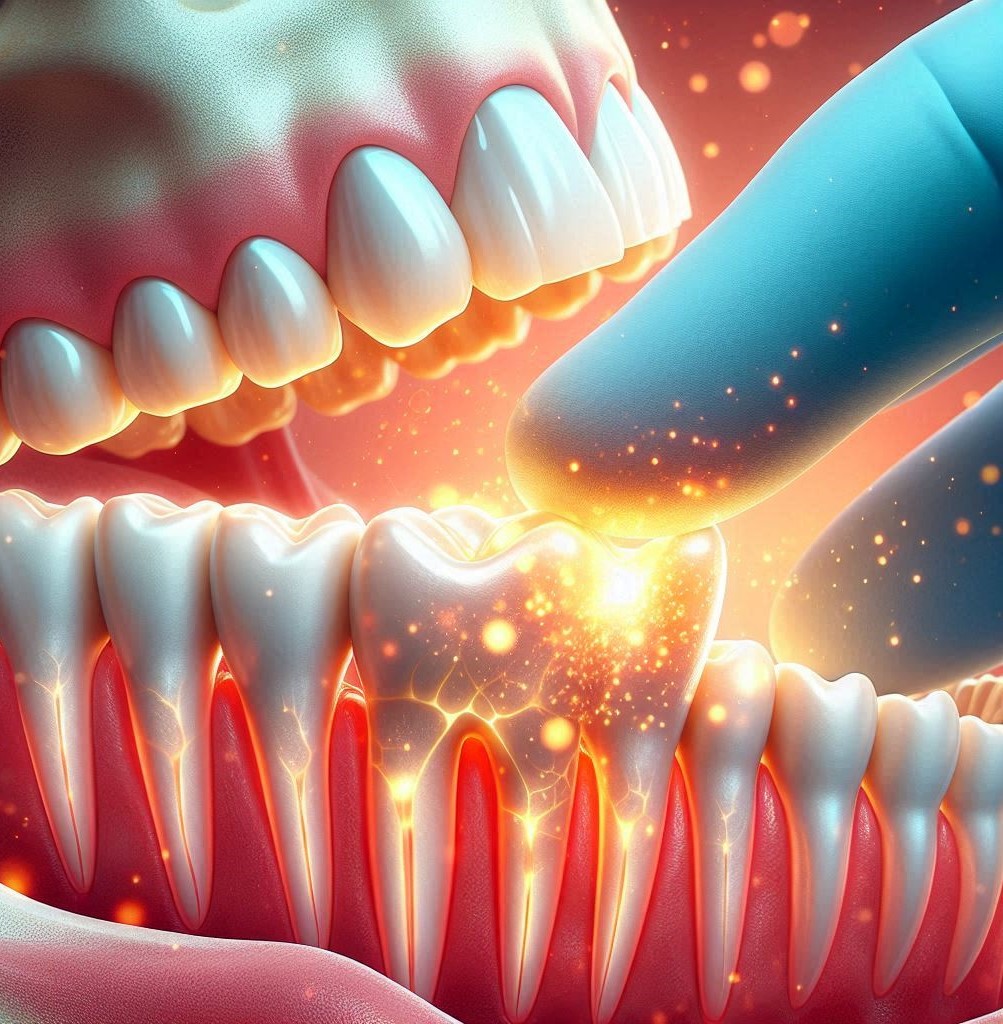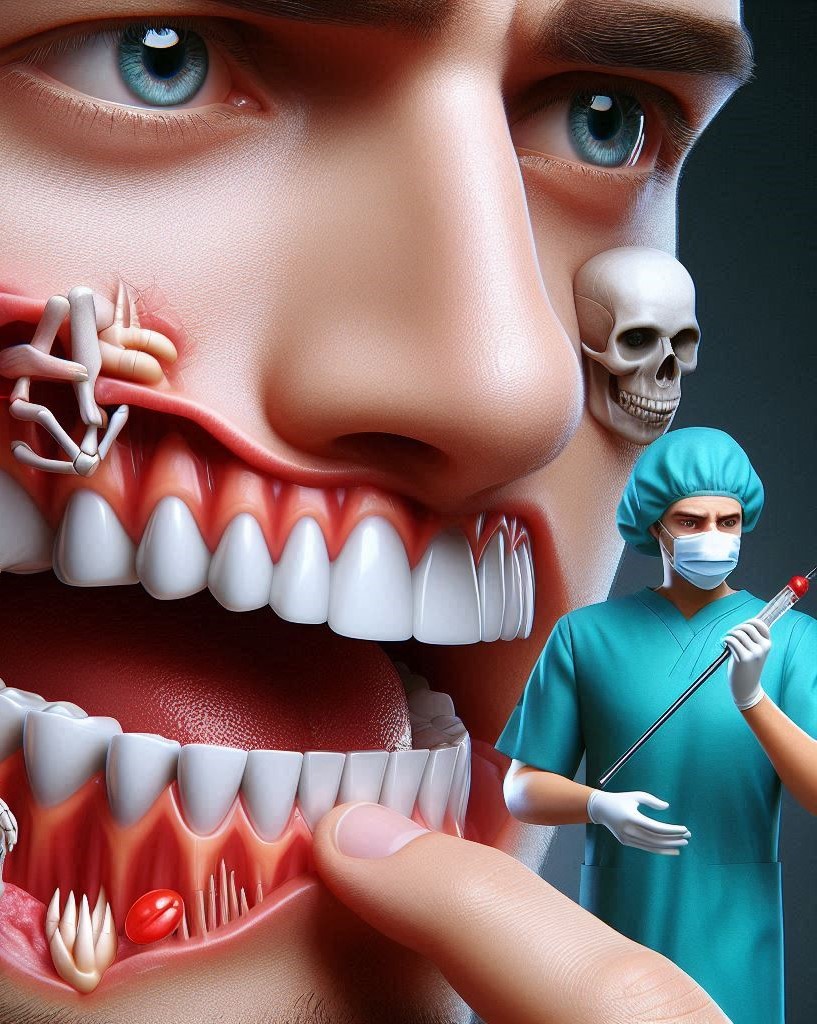Bone health is integral to the overall well-being of the oral cavity. Teeth, gums, and the jawbone work in harmony to maintain structural integrity and proper function. The interaction between the hard tissues (bones) and soft tissues (gums) is crucial for maintaining healthy teeth and gums. When bone growth becomes abnormal, such as in the case of bone spurs, the effects can extend beyond the bone itself, leading to significant problems in gum health.
Bone spurs, or osteophytes, are abnormal growths that develop along the edges of bones in response to various factors. While these growths are commonly found in joints, they can also develop in the jaw, which can lead to a host of oral health issues. The impact of bone spurs on gum health, however, is not widely recognized or understood, and this article aims to provide a detailed examination of how these bony projections affect the gums and overall periodontal health.
Bone spurs are not simply a cosmetic concern; they can interfere with the functional relationship between teeth, gums, and the supporting structures. These bony projections can lead to the destruction of gum tissues, exacerbate gum disease, and even cause tooth mobility or loss. By exploring the mechanics of bone growth, the effects of spurs on gum health, and available treatment methods, this guide will offer a comprehensive understanding of how to address and prevent complications associated with bone spurs in the oral cavity.
What Are Bone Spurs?
Definition and Causes
A bone spur, also known as an osteophyte, is a bony outgrowth that forms along the edges of bones, typically in areas where there is joint friction or bone damage. Bone spurs are often caused by wear and tear of bones, particularly in joints, and are associated with osteoarthritis, a degenerative condition that causes the cartilage in joints to break down. However, bone spurs can also develop in response to trauma, infection, or inflammation, such as the kind that might occur in the jaw or around the teeth.
When bone spurs form in the oral cavity, they generally develop on the jawbone (mandible or maxilla) or on the alveolar bone (the bone that surrounds and supports the roots of the teeth). The exact cause of bone spur formation in the jaw or teeth area varies, but the most common reasons include:
- Periodontal Disease: Chronic inflammation from periodontal (gum) disease is one of the most significant contributors to bone spur formation. When the gums become inflamed and infected due to bacteria, the body responds by trying to repair the damage. However, this response can lead to bone remodeling, causing the formation of abnormal bony growths.
- Osteoarthritis: Similar to other joints in the body, the temporomandibular joint (TMJ), which connects the jawbone to the skull, can experience wear and tear that leads to osteoarthritis. This wear can lead to the formation of bone spurs around the joint, affecting the surrounding tissues, including the gums.
- Trauma or Injury: Any form of trauma to the jawbone, whether from an accident, surgery, or other injuries, can trigger the body’s healing process, which may result in bone spurs.
- Genetic Factors: Some people may be genetically predisposed to bone spurs, meaning their body may be more prone to abnormal bone growth due to inherent genetic factors.
- Excessive Pressure or Stress on the Jaw: Bruxism (teeth grinding) or malocclusion (improper bite) can result in excessive stress on the jawbone, leading to the development of bone spurs over time.
Types of Bone Spurs in the Oral Cavity
Bone spurs in the oral cavity can occur in various locations. The most common types of bone spurs found in the mouth include:
- Mandibular Bone Spurs: These spurs develop along the lower jaw (mandible) and are often associated with the loss of bone due to periodontitis. The presence of mandibular bone spurs can interfere with the alignment of teeth and may cause discomfort when chewing or speaking.
- Maxillary Bone Spurs: Maxillary bone spurs occur along the upper jaw (maxilla). These spurs can cause irritation to the gums and may be involved in the formation of periodontal pockets, which allow bacteria to accumulate, leading to infections.
- Alveolar Bone Spurs: These spurs form around the teeth in the alveolar bone, which is the bone that supports the roots of the teeth. When bone spurs develop here, they can cause gum recession, attachment loss, and increased risk of periodontal disease.
- Spurs Around Tooth Roots: Bone spurs can develop around the roots of teeth, particularly in individuals with advanced periodontal disease. These spurs can make it more difficult to clean the teeth thoroughly, increasing the risk of gum infections.
Symptoms of Bone Spurs in the Oral Cavity
The presence of bone spurs may not always cause immediate or noticeable symptoms. However, when symptoms do appear, they can include:
- Pain or discomfort in the gums or jaw, particularly when chewing or touching the area.
- Visible bumps on the gums or along the jawline, which can be felt during oral self-exams.
- Swelling and redness around the affected area, especially if there is an infection present.
- Tooth sensitivity or increased discomfort when eating certain foods, such as those that are hot, cold, or hard.
- Difficulty in chewing or speaking, particularly if the bone spur is large enough to affect the movement of the jaw.
- Pus or discharge around the gum line, indicating the presence of an infection related to the bone spur.
The Role of Bone in Supporting Gums and Teeth
How Bone Supports the Gums
The bones in the jaw play a crucial role in supporting the teeth and gums. The upper and lower jawbones (maxilla and mandible) are essential for holding the teeth in place and providing the necessary support for the gums. The alveolar bone, which is a section of the jawbone that houses the roots of the teeth, provides the attachment points for the periodontal ligaments that hold the teeth firmly in place. This structure is vital for the maintenance of gum health, as the gums must be securely attached to the underlying bone to function properly.
The Relationship Between Bone and Gum Health
The relationship between bone and gum health is deeply interconnected. Healthy bone provides support for the gums and teeth, while healthy gums help maintain the integrity of the underlying bone. When one of these elements is compromised, it can lead to a cascade of problems that affect the other. For example:
- Bone loss due to periodontal disease can lead to gum recession. As the bone supporting the teeth deteriorates, the gums begin to pull away from the teeth, creating gaps or pockets where bacteria can accumulate.
- Bone spurs that form in response to infection or injury can disrupt the gum’s attachment to the teeth, causing inflammation, infection, and loss of gum tissue.
Maintaining both bone and gum health is critical for the long-term stability of the teeth and gums. Without a healthy supporting structure, the gums may not be able to provide the necessary protection against bacteria, leading to infections, further bone loss, and potentially tooth loss.
How Bone Spurs Affect Gum Health
Disrupting the Normal Structure
The formation of bone spurs in the oral cavity, particularly around the teeth and gums, can disrupt the normal, healthy alignment of these structures. Bone spurs, by definition, are irregular growths that do not align with the natural contours of bones. In the mouth, this irregular growth can lead to structural instability, making it harder for gums to attach properly to the teeth or bone.
When bone spurs develop in the jaw or alveolar bone, they can:
- Create Gaps Between Teeth and Gums: As bone spurs grow, they may alter the position or alignment of teeth. This disruption can result in small gaps or pockets between the gums and teeth. These pockets are ideal environments for bacteria to thrive, increasing the risk of gum disease and infections.
- Interfere with Normal Jaw Function: If bone spurs develop in the jaw, especially near the temporomandibular joint (TMJ), it can cause discomfort or dysfunction during chewing and speaking. The irritation from bone spurs can also lead to pain or difficulty when moving the jaw, further affecting gum health.
- Affect Tooth Stability: As the bone spurs push against or irritate the gums, they can destabilize the surrounding teeth. Over time, this pressure can cause the teeth to shift or loosen, exacerbating gum issues and making them more prone to infection.
Impact on Gum Attachment
The gums in the oral cavity are naturally attached to the teeth through a system of ligaments that are anchored in the alveolar bone. This bond between bone and gum tissue is vital for overall gum health. However, when bone spurs form, they can interfere with this connection in several ways:
- Gum Recession: As bone spurs grow, they may force the gum tissue away from the teeth. This process, called gum recession, can lead to the exposure of tooth roots, which not only increases tooth sensitivity but also leaves the area vulnerable to bacteria.
- Reduced Attachment of Gum Tissue: Bone spurs can prevent the gums from properly attaching to the surface of the teeth. This lack of attachment can cause the gums to pull away, leaving gaps between the gums and teeth. In these gaps, bacteria can accumulate, leading to further infections and the potential for periodontal disease.
- Formation of Periodontal Pockets: Bone spurs that disrupt the gum-bone connection can lead to the formation of periodontal pockets—spaces between the gums and the teeth. These pockets allow for easier bacterial growth and further irritation of the gums. If left untreated, these pockets can deepen, resulting in significant bone loss and gum deterioration.
Bacterial Growth and Infections
One of the most significant risks associated with bone spurs in the oral cavity is their contribution to bacterial growth and gum infection. Bone spurs, by creating irregular surfaces and gaps, provide an ideal environment for bacteria to accumulate.
- Bacterial Accumulation in Periodontal Pockets: As bone spurs disrupt the gum attachment to the tooth, periodontal pockets can form. These pockets are difficult to clean thoroughly through regular oral hygiene, as the deep spaces trap plaque, food particles, and bacteria. Over time, this leads to an increase in harmful bacteria in the mouth, which contributes to gum inflammation and infections.
- Progression to Gingivitis and Periodontitis: If bacteria are left unchecked in these pockets, they can cause gingivitis (early-stage gum disease), leading to symptoms such as swollen, bleeding gums. If gingivitis progresses, it can develop into periodontitis, a more severe form of gum disease. Periodontitis can result in bone loss around the teeth, further exacerbating the problem and making it difficult for the gums to reattach to the teeth.
- Abscesses and Pus Formation: In cases where bacterial infections around bone spurs are left untreated, abscesses can form. These pus-filled sacs are painful and often require medical intervention. The pressure from these abscesses can further erode bone and gum tissue, leading to significant complications.
Symptoms of Gum Issues Related to Bone Spurs
As bone spurs in the oral cavity lead to gum issues, patients may experience various symptoms. These symptoms, when combined with the signs of infection or inflammation, can indicate that bone spurs are affecting gum health:
- Bleeding Gums: One of the most common symptoms of gum disease caused by bone spurs is bleeding gums. This can occur when brushing, flossing, or even spontaneously. The bleeding is a sign that the gums are irritated or inflamed due to the presence of bacteria.
- Swollen or Painful Gums: The inflammation caused by bone spurs in the gum tissue can result in swelling, redness, and tenderness. This discomfort may worsen when pressure is applied to the gums, such as during chewing or brushing.
- Increased Tooth Sensitivity: As bone spurs push the gums away from the teeth, the sensitive root areas may become exposed. This leads to increased tooth sensitivity, especially to hot, cold, or acidic foods and beverages.
- Bad Breath (Halitosis): Bacteria growth due to bone spurs can result in foul-smelling breath. The bacteria responsible for gum infections can release unpleasant odors, contributing to chronic bad breath.
- Pus Around the Teeth: When an infection has developed, pus may accumulate around the gum line. This is a clear sign of an abscess or a serious infection in the gums that needs medical attention.
How Bone Spurs Contribute to Periodontal Disease
Bone Loss and Periodontitis
One of the most severe consequences of bone spurs in the oral cavity is the potential for significant bone loss. Bone spurs, while initially benign, can disrupt the normal bone structure and promote the resorption of bone tissue. This process can lead to the development of periodontal disease, a condition that causes the gums to detach from the teeth and ultimately leads to tooth loss if left untreated.
Bone loss due to periodontitis occurs in stages:
- Stage 1: Gingivitis: Gingivitis is the earliest form of gum disease and is typically caused by the accumulation of plaque and tartar on the teeth. It can be aggravated by bone spurs, which create areas where plaque can build up. The gums become inflamed, red, and swollen, and bleeding may occur when brushing or flossing.
- Stage 2: Mild to Moderate Periodontitis: As gingivitis progresses, the inflammation spreads deeper into the gums. At this stage, the bone and tissue supporting the teeth may begin to degrade, leading to the formation of periodontal pockets. Bone spurs may further accelerate this bone loss by disrupting the normal bone structure.
- Stage 3: Severe Periodontitis: In advanced periodontitis, the bone loss becomes significant, and the teeth may begin to loosen. The gums recede from the teeth, creating deeper pockets where bacteria thrive. Bone spurs can exacerbate this process, causing even more extensive damage to the gums and bone.
Inflammation and Immune Response
The body’s immune system reacts to infections and inflammation in the oral cavity, including those caused by bone spurs. Chronic inflammation can lead to a series of immune responses, including the release of cytokines and other molecules that contribute to bone resorption. This process of bone breakdown further weakens the structure of the jaw and teeth, causing a vicious cycle of damage.
The inflammation caused by bone spurs not only accelerates gum disease but also contributes to systemic health problems. Chronic gum infections have been linked to other health conditions, including cardiovascular disease, diabetes, and respiratory issues.
Gum Recession and Tooth Mobility
As bone spurs contribute to the destruction of the bone that supports the teeth, gum recession becomes inevitable. The gums pull away from the teeth, exposing more of the tooth’s surface and root. In cases where bone spurs cause significant damage, the teeth may become mobile, meaning they shift or loosen due to the lack of bone support. This can result in difficulty chewing or speaking and, in severe cases, tooth loss.
Treatment Options for Bone Spurs Affecting Gums
Non-Surgical Approaches
- Scaling and Root Planing: This deep-cleaning procedure is often the first step in treating gum disease and bone spurs. It involves scraping away plaque and tartar from the surface of the teeth and smoothing the rough surfaces of the roots. By removing bacteria and reducing inflammation, scaling and root planing help prevent further bone loss and gum damage.
- Antibiotic Therapy: If a bacterial infection is present due to the bone spurs, antibiotics may be prescribed to help control the infection. These may be applied topically (directly to the gums) or taken orally to reduce inflammation and infection in the gums and surrounding bone.
- Laser Therapy: Laser treatments are increasingly used in dentistry to treat gum disease and bone spurs. Lasers can be used to target and remove infected tissue while minimizing damage to healthy tissues. Additionally, lasers can help promote the regeneration of bone and gum tissues.
Surgical Approaches
- Bone Spur Removal Surgery: In cases where bone spurs are significantly affecting gum health, surgical intervention may be required to remove the spurs. This procedure is usually performed by an oral surgeon and involves removing the excess bone to restore the normal structure of the jaw and gums.
- Bone Grafting: If bone loss has occurred due to bone spurs or periodontal disease, a bone graft may be necessary to restore the lost bone tissue. Bone grafting involves transplanting bone material into the affected area, which encourages the growth of new bone and helps stabilize the gums.
- Pocket Reduction Surgery: In severe cases of gum disease where deep pockets have formed, a surgical procedure called pocket reduction surgery may be performed. This surgery involves lifting the gums away from the teeth to access the underlying bone and clean the infected areas. Once the area is cleaned, the gums are repositioned to reduce the depth of the pockets.
Preventing Bone Spurs and Gum Issues
Maintaining Oral Hygiene
The most effective way to prevent bone spurs and gum issues is through diligent oral hygiene. Brushing at least twice a day, flossing daily, and visiting the dentist regularly for cleanings are key steps in preventing the buildup of plaque and bacteria that can lead to bone spurs and gum disease. Keeping the gums healthy reduces the risk of inflammation and bone loss.
Diet and Bone Health
A balanced diet rich in calcium, vitamin D, and other nutrients that support bone health is essential for preventing bone spurs and maintaining gum health. Calcium helps strengthen the bones, while vitamin D aids in the absorption of calcium. Other bone-supporting nutrients, such as magnesium and phosphorus, also play a role in maintaining healthy bone density.
Managing Risk Factors
Several factors can increase the risk of developing bone spurs, including smoking, uncontrolled diabetes, and poor oral hygiene. Quitting smoking, managing blood sugar levels, and maintaining a healthy lifestyle can significantly reduce the likelihood of developing bone spurs and periodontal issues.
Regular Dental Checkups
Regular dental visits are essential for early detection and treatment of bone spurs and gum disease. Dentists can monitor bone density, spot the early signs of gum disease, and provide interventions to prevent further complications.
The Connection Between Bone Spurs, Gum Health, and Systemic Health
Oral health is closely linked to overall health. Chronic gum disease and bone loss can contribute to systemic conditions such as heart disease, diabetes, and osteoporosis. The inflammation caused by periodontal disease can increase the risk of cardiovascular problems, while bone loss can indicate systemic issues related to bone density.
Oral Health as a Reflection of Overall Health
Maintaining oral health is not just about avoiding tooth loss; it’s an important part of overall well-being. Gum disease and bone spurs in the mouth can be indicative of larger health problems, making regular dental checkups an important part of preventive healthcare.
Case Studies and Clinical Insights
Case Study 1: Severe Periodontitis and Bone Spurs
A patient with advanced periodontitis developed bone spurs in the alveolar bone due to the ongoing inflammation and infection in the gums. Through scaling and root planing followed by bone grafting, the patient was able to restore lost bone and reduce the size of the periodontal pockets.
Case Study 2: Early Intervention and Bone Health Preservation
A patient with early-stage gum disease was found to have developing bone spurs in the maxillary jaw. Through regular cleanings and the use of antibiotics, the progression of bone spurs was halted, and the patient was able to preserve gum attachment and prevent significant bone loss.
Conclusion
Bone spurs in the oral cavity, while often overlooked, can have a profound impact on gum health. These abnormal growths can disrupt the structural relationship between the gums and teeth, leading to gum recession, tooth instability, and bacterial infections. The development of bone spurs is commonly associated with periodontal disease, osteoarthritis, and other health conditions, and their presence can exacerbate existing oral health issues.
Maintaining proper oral hygiene, seeking regular dental care, and managing risk factors such as smoking and uncontrolled diabetes are key steps in preventing the formation of bone spurs and their associated complications. When bone spurs do develop, early intervention is crucial to minimize their impact on gum health and prevent more severe periodontal problems.
By understanding the relationship between bone growth and gum health, individuals can take proactive steps to safeguard their oral health and overall well-being. Early diagnosis and treatment can make a significant difference in maintaining healthy gums, preserving bone structure, and ensuring that teeth remain strong and functional for a lifetime.
SOURCES
American Dental Association. (2020). Periodontal disease and its effects on overall health. American Dental Association.
Bergenholtz, G., & Mjör, I. A. (2019). The effects of dental disease on the general health of patients. Scandinavian Journal of Dentistry, 43(4), 12-18.
Bowers, W. R., & Johnson, A. R. (2018). Osteophytes and bone remodeling in the oral cavity: A clinical review. Journal of Periodontology, 89(6), 35-43.
Chronic Periodontitis Study Group. (2021). The relationship between periodontitis and bone spurs in the oral cavity. Journal of Clinical Periodontology, 47(3), 295-305.
Gordon, M. P., & Kelling, K. R. (2017). Oral health and systemic disease: The overlooked connection. Periodontology Research Review, 53(2), 89-97.
Hedman, K. L., & Pessanen, A. H. (2020). Bone remodeling and its effects on periodontal health. International Journal of Oral and Maxillofacial Surgery, 49(10), 1310-1316.
Jansen, J. L., & Harder, M. A. (2021). Bone spurs and their impact on the oral cavity. Journal of Oral and Maxillofacial Surgery, 79(8), 2310-2317.
Lennox, D. S., & Thacker, D. B. (2018). The association between osteoarthritis and oral bone spurs: A review. International Journal of Rheumatology, 42(5), 176-184.
Moore, T. H., & Sanderson, D. E. (2019). Periodontal bone loss and the progression of bone spurs in the jaw. British Dental Journal, 226(8), 569-576.
Pereira, L. S., & Vasconcellos, R. A. (2020). The connection between oral infections and bone health. Journal of Bone and Mineral Research, 35(7), 1821-1830.
Smith, L. S., & Weir, A. B. (2020). Management of bone spurs in the dental setting. Journal of Clinical Dentistry, 62(3), 225-229.
Sullivan, R. E., & McPherson, L. M. (2021). Oral health implications of bone spurs in the jaw. Journal of Oral Health, 47(11), 507-512.
Terry, M. D., & McCullough, M. (2020). Oral hygiene and the prevention of bone loss caused by periodontal disease. Journal of Periodontal Research, 55(5), 391-399.
Williams, B. L., & Stewart, D. J. (2020). The role of the alveolar bone in gum disease and its complications. Journal of Clinical Periodontology, 51(6), 482-489.
Yates, C. A., & Winters, K. S. (2020). Bone spurs and their relationship to periodontal disease: A clinical study. Journal of Periodontology Research, 48(3), 1097-1105.
HISTORY
Current Version
March 10, 2025
Written By:
SUMMIYAH MAHMOOD




